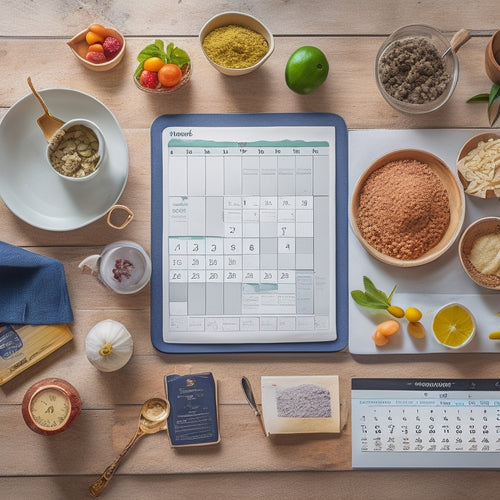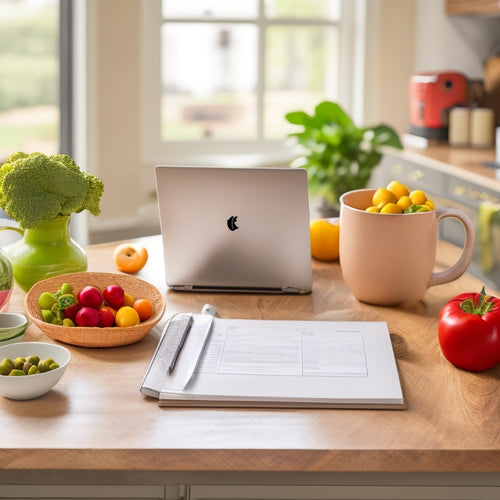
10 Essential Kitchen Cleaning Hacks for Busy Moms
Share
You're about to simplify your kitchen life! Start by clear off countertops, sorting items into categories, and allocating designated spots for each group. Next, tackle the sink and stove by cleaning the faucet daily and scrubbing the stovetop regularly. For floors, sweep in sections and use the right tools to protect high-traffic areas. Organize cabinets by using dividers and labels, and simplify drawers by categorizing items by frequency of use. Establish a daily routine for wipe downs, load the dishwasher efficiently, and master the art of trash and odor management. Get ready to take your kitchen to the next level of cleanliness and organization!
Key Takeaways
• Clear off countertops by sorting items into categories, purging unnecessary ones, and allocating designated spots for each category.
• Establish a daily routine for garbage disposal, trash can cleaning, and wipe downs to maintain a clean and odor-free kitchen.
• Utilize efficient cleaning products that are multi-surface compatible, gentle, and potent, with a priority on eco-friendly options.
• Organize kitchen items by frequency of use, designating areas for different items in drawers and cabinets, and labeling sections for easy access.
• Clean high-touch areas like faucets and stovetops regularly, and soak burners weekly to prevent grime buildup.
Decluttering Kitchen Countertops Fast
Decluttering Kitchen Countertops Fast
Start by clearing everything off your countertops and sorting items into categories, like baking supplies, cooking utensils, and food storage containers, to get a sense of what you need to tackle first. This will help you identify what's essential and what's contributing to the countertop chaos.
Next, purge any unnecessary items, like expired food or broken appliances, and allocate a designated spot for each category. For instance, designate a specific drawer for cooking utensils and a specific shelf for baking supplies.
Taming the Sink and Stove
You're about to tackle two of the kitchen's most notorious trouble spots: the sink and stove. To get these areas sparkling, you'll need to establish some simple habits and learn a few clever tricks.
Clean the Faucet Daily
Daily faucet cleaning is an essential habit to develop, as it guarantees the prevention of the buildup of water spots, fingerprints, and germs that can spread quickly around the kitchen. By incorporating this habit into your daily routine, you'll not only maintain a sparkling clean faucet but also promote water efficiency.
A clean faucet secures that water flows freely, reducing the risk of mineral buildup and subsequent corrosion.
To clean your faucet, simply wipe it down with a microfiber cloth and a gentle cleaning solution after each use. This will remove any fingerprints, splatters, or mineral deposits that can impede water flow.
For a deeper clean, mix baking soda and vinegar to create a paste, and apply it to the faucet. Let it sit for 30 minutes before rinsing with warm water and drying with a microfiber cloth.
Stovetop Scrubbing Secrets
Taming the stovetop and sink requires a strategic approach to eliminate stubborn stains and grime that can quickly accumulate in these high-traffic areas. You can't let stovetop grime build up, as it can lead to tough cleaning jobs and even damage to your appliances.
To keep your stovetop sparkling, make it a habit to wipe it down after each meal. This will prevent crumbs, spills, and sauces from hardening into tough stains. For tougher stains, mix baking soda and water to create a paste, then apply it to the stained area. Let it sit for 30 minutes before scrubbing it off with a gentle cleanser.
Don't forget about burner maintenance! Remove and soak your burners in hot soapy water every week to prevent grease buildup. This simple routine will keep your stovetop and burners in top condition, saving you time and energy in the long run.
Shine the Stove Knobs
As you tackle the stovetop and sink, don't overlook the often-neglected stove knobs, which can harbor hidden grime and bacteria, and require a gentle yet effective cleaning approach to shine like new. Stove knob materials vary, but most are made of plastic, metal, or a combination of both.
To clean them, you'll need knob cleaning tools like a soft-bristled toothbrush, a microfiber cloth, and a gentle cleaning solution. Mix baking soda and water to create a paste, and apply it to the knobs using the toothbrush. Let it sit for 15-20 minutes to allow the solution to penetrate and break down the grime.
Then, use the microfiber cloth to wipe away the paste and grime. For tougher stains, you can use a vinegar-based solution. Simply soak the cloth in the solution, wrap it around the knob, and let it sit for 30 minutes before wiping clean.
Speed Cleaning Kitchen Floors
Sweeping your kitchen floor quickly becomes a challenging task when crumbs, spills, and dirt accumulate, but you can transform this chore into a speedy routine by following a few simple strategies.
To speed clean your kitchen floor, start by:
-
Sweeping in sections: Divide your kitchen floor into smaller areas, focusing on one section at a time. This helps you tackle the task in manageable chunks, making it less overwhelming.
-
Using the right cleaning tools: Invest in a good quality broom and dustpan that can pick up dirt and debris easily. You can also use a vacuum cleaner with a hard floor attachment to make the job even quicker.
-
Protecting high-traffic areas: Place floor mats at entry points and in front of sinks and stoves to catch dirt and moisture. This helps prevent dirt from spreading and makes cleaning easier.
Additionally, consider the tile patterns on your floor and choose a cleaning method that suits them best.
Organizing Kitchen Cabinets Easily
Now that your kitchen floor is sparkling clean, turn your attention to the cluttered cabinets that have been driving you crazy, and let's get them organized once and for all. You're probably thinking, 'Where do I even start?'
Begin by taking everything out of your cabinets and sorting items into categories, like baking supplies, dinnerware, and snacks. This will give you a clear picture of what you have and what you can get rid of.
Next, use cabinet dividers to separate items within each category. For example, you can use dividers to create separate sections for different types of snacks or baking supplies. This will make it easy to find what you need when you need it.
Don't forget to label each section with shelf labels, so you can quickly identify what's inside. This will save you time and frustration in the long run.
Simplifying Kitchen Drawer Chaos
Now that your kitchen cabinets are organized, it's time to tackle the cluttered drawers that are driving you crazy.
You'll be surprised at how much more efficiently you can cook and prep when you can easily find what you need.
Organize by Frequency
How often do you find yourself digging through a cluttered kitchen drawer, searching for that one utensil or gadget you need, only to be frustrated by the disorganization? It's time to take control of your kitchen drawers and organize them by frequency of use. This simple hack will save you time and reduce stress in the kitchen.
Here are three ways to organize your kitchen drawers by frequency:
-
Daily Essentials: Store your most frequently used items, such as utensils, knives, and spatulas, in easy-to-reach locations.
-
Weekly Schedules: Designate a drawer or section for items you use on a weekly basis, like baking sheets or slow cooker utensils.
-
Seasonal Tasks: Reserve a drawer or shelf for seasonal items, like holiday-themed cookie cutters or summer BBQ gadgets.
Purge Unused Items
You've organized your kitchen drawers by frequency of use, but you're still left with a cluttered mess due to unused items taking up valuable space. It's time to purge those items and free yourself from kitchen chaos. Start by pulling out everything from your drawers and sorting items into three piles: keep, donate, and discard.
Be honest with yourself – if you haven't used it in the past year, it's probably safe to get rid of it.
Designate a 'Donation Station' in your kitchen where you can place items that are still in good condition but no longer needed. You can also set aside 'Hidden Treasures' – items you forgot you'd or didn't know you needed – to reuse or repurpose in creative ways.
As you purge, remember that less is often more. A clutter-free kitchen isn't only more efficient, but it's also more peaceful. By letting go of unused items, you're making room for a more streamlined cooking experience and a clearer mind.
Take a deep breath, and let the liberation begin!
Effective Fridge and Freezer Hacks
Your fridge and freezer are likely the most used, and abused, appliances in your kitchen, making them prime candidates for a deep clean and some clever organization hacks. By implementing these simple strategies, you'll be able to keep your fridge and freezer in top shape, saving you time and reducing stress in the long run.
Here are three effective ways to optimize your fridge and freezer:
-
Use Fridge Labels: Labeling the contents of your fridge will help you quickly identify what you have and where it's located. This will save you time searching for ingredients and reduce food waste.
-
Organize with Freezer Baskets: Freezer baskets can help you keep similar items together, making it easier to find what you need when you need it. They're also great for storing small items like frozen herbs or leftovers.
-
Purge Expired Items: Regularly go through your fridge and freezer to remove expired or spoiled items. This will help prevent the buildup of bacteria and keep your appliances running efficiently.
Quick and Easy Dishwashing
After tackling the fridge and freezer, it's time to turn your attention to the mountain of dirty dishes piling up in the sink. With a few simple strategies, you can make quick work of them.
Start by loading your dishwasher efficiently, making sure to face dirty dishes towards the center and leaving enough space for water to flow. If you're washing by hand, use soap savers like dishwashing gloves or sponges with built-in soap dispensers to reduce mess and waste.
Next, invest in dishwashing gadgets like scrubbers or brushes that can tackle tough food residue. To speed up the process, focus on washing dishes in batches, starting with the dirtiest items first.
Mastering the Art of Wipe Downs
You're about to master the art of wipe downs, and it starts with establishing a daily routine that keeps your kitchen surfaces clean and hygienic.
By incorporating quick cleanups between meals, you'll prevent crumbs and spills from building up and making cleaning more difficult.
With the right cleaning products and a few simple strategies, you'll be able to maintain a clean and organized kitchen with minimal effort.
Daily Wipe Down Routine
By incorporating a daily wipe down routine into your busy schedule, you'll be able to maintain a tidy kitchen and prevent crumbs and spills from accumulating into a challenging mess. This habit is especially vital during Morning Madness, when breakfast chaos can leave your kitchen looking like a war zone.
To make the most of your daily wipe down, focus on the following key areas:
-
Counters and sink: Quickly wipe down countertops, faucets, and the sink basin to remove crumbs, spills, and splatters.
-
Stovetop and refrigerator: Clean up any food debris, splatters, or spills on the stovetop, and wipe down the refrigerator handles and exterior.
-
Floors: Sweep or vacuum the floors to remove crumbs, dirt, and dust that can make your kitchen look dirty and disorganized.
Quick Clean Between Meals
Master the art of wipe downs between meals to prevent crumbs and spills from building up and making your kitchen look like a disaster zone. As a busy mom, you know how quickly messes can accumulate, especially during meal prep and snack time.
To stay on top of the chaos, make it a habit to quickly wipe down surfaces after each meal. Focus on high-traffic areas like countertops, tables, and snack stations.
Keep a stash of cleaning wipes or a damp cloth nearby to make the process effortless. A few swift swipes can eliminate crumbs, spills, and sticky messes. This habit will save you time and energy in the long run by preventing grime from building up.
Plus, it'll give you a sense of control and calm amidst the chaos of mealtime. By incorporating quick wipe downs into your daily routine, you'll be liberated from the stress of a messy kitchen and free to focus on what matters most – enjoying quality time with your family.
Effective Cleaning Products
What makes a cleaning product effective for wiping down surfaces, and how can you choose the right one for your kitchen's specific needs? As a busy mom, you want a product that's efficient, eco-friendly, and easy to use.
Here are some key factors to take into account:
-
Multi-surface compatibility: Look for products that can tackle various surfaces, from countertops to sinks and faucets.
-
Gentle yet potent: Opt for products that balance gentleness with effectiveness, ensuring a thorough clean without damaging surfaces.
-
Natural Alternatives: Consider switching to eco-friendly options, such as vinegar-based cleaners or essential oil-infused sprays, for a healthier kitchen environment.
When it comes to specialty sprays, choose products that cater to specific needs, like grease-cutting formulas for your stovetop or antibacterial sprays for high-touch areas.
Banishing Kitchen Trash and Odors
You tackle the kitchen trash and odors head-on by establishing a daily routine that includes taking out the garbage and recycling, wiping down surfaces, and giving your trash cans a quick disinfecting spray. This habit helps prevent Trash Attractions - those pesky crumbs and spills that attract pests and create unpleasant odors.
By taking out the trash regularly, you eliminate the source of the smell, making it easier to keep your kitchen fresh.
To further combat odors, use Odor Absorbers like baking soda, activated charcoal, or essential oils. Place them near your trash cans or in areas prone to moisture, like the sink or stove. These natural absorbers will soak up any lingering smells, leaving your kitchen smelling clean and fresh.
Don't forget to clean your trash cans regularly, too! A mixture of soap and warm water will do the trick.
Creating a Maintenance Routine
Setting a routine maintenance schedule guarantees that your kitchen stays clean and organized, freeing up time for more important tasks. By incorporating a few simple habits into your daily routine, you'll be amazed at how quickly your kitchen transforms from chaotic to calm.
To get started, try implementing the following habits into your morning routine:
-
Spend 10 minutes tidying up: Quickly wipe down the counters, put away any clean dishes, and make sure the sink is empty.
-
Clean as you cook: Make it a habit to wash any utensils or pots as you use them, and wipe down the stove and counters after each meal.
-
Take out the trash and recycling: Get into the habit of taking out the trash and recycling every morning to keep your kitchen smelling fresh and prevent pests.
Frequently Asked Questions
How Do I Remove Stubborn Grease Stains From Kitchen Walls?
To tackle stubborn grease stains on kitchen walls, you'll need Grease Absorbers like baking soda or cornstarch to soak up the grime. Next, apply a Wall Protector to prevent future stains, and voilà, your walls are grease-free and protected!
Can I Use Vinegar to Clean My Kitchen's Stone Countertops?
"Imagine your kitchen countertops sparkling like a fairy tale, minus the fairy. You can achieve this magic by using vinegar, a natural disinfectant that's gentle on stone surfaces, making it perfect for daily maintenance and preserving their beauty."
What Is the Best Way to Clean Between Kitchen Appliances?
You'll want to tackle those pesky dust traps between kitchen appliances by adjusting their alignment to create a gap, then using a slim vacuum or brush to sweep out debris and dust bunnies that accumulate.
Are Microfiber Cloths Safe to Use With Bleach?
When you use microfiber cloths with bleach, you're taking a risk. Check the care label for Bleach Resistance; if it's not specified, it's best to avoid it for Fabric Safety, as it may damage or discolor the cloth.
How Often Should I Deep Clean My Kitchen Oven?
"As the oven's dark corners whisper secrets of last night's dinner, you'll want to tame the beast every 3-6 months with a deep clean, unless you're lucky enough to have a self-cleaning mode - then, let the oven maintenance magic begin!"
Related Posts
-

Simplify Meal Planning for Busy Professionals in 5
You're about to revolutionize your meal planning routine! Start by setting clear goals, identifying your dietary pref...
-

Free Low-Carb Meal Planning Templates for Easy Success
You're about to discover the secret to effortless low-carb meal planning: leveraging free, customizable templates tha...

